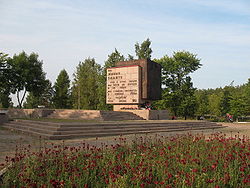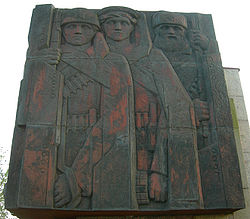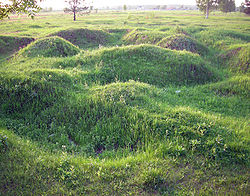
Nevsky Pyatachok
Encyclopedia


Shlisselburg
Shlisselburg is a town in Leningrad Oblast, Russia, situated at the head of the Neva River on Lake Ladoga, east of St. Petersburg. From 1944 to 1992, it was known as Petrokrepost...
. It was the site of one of the most critical and costly campaigns during the Siege of Leningrad
Siege of Leningrad
The Siege of Leningrad, also known as the Leningrad Blockade was a prolonged military operation resulting from the failure of the German Army Group North to capture Leningrad, now known as Saint Petersburg, in the Eastern Front theatre of World War II. It started on 8 September 1941, when the last...
from September 1941 until May 1943 to reopen land communications with the city during the German siege.
Campaign for the land communications
The area between Shlisselburg and the bend of the Neva to the south represented the land link between the Soviet-controlled territory and the city defence perimeter. The Red Army objective was to retain this narrow stretch of the shore and prevent German forces from completing the blockade, thus allowing transports to reach the population in besieged Leningrad with food, medications and other supplies.The area was first defended by the Red Army's Krasnogvardeisk Fortified Region, the 55th and the 48th Armies which included the 45th Guards, 115th, 86th, 168th, 10th Rifle Divisions, 1st NKVD Rifle Division and 4th Separate Naval Infantry Brigade. On 7 September 1941 the German 20th Motorised Division was able to force the elements of the 48th Army out of Shlisselburg, setting the stage for a more than two-year struggle to reopen the land communications with Leningrad by the Red Army.
Initially the Germans secured the area. On September 20, 1941, the Soviets managed to cross the river and establish the bridgehead, but they failed to enlarge it. The Germans managed to eliminate the bridgehead by April 29, 1942, but it was re-established on September 26, 1942.
The battle for Nevsky Pyatachok extended from January 1942 to May 1943.
In 1942 the area was a scene of heavy fighting for the German XXVIII Army Corps which, from October 1942, was under a constant assault by the 67th Army.
Eventually Leonid Govorov
Leonid Govorov
Leonid Aleksandrovich Govorov was a Soviet military commander. An artillery officer, he joined the Red Army in 1920. He graduated from several Soviet military academies, including the Military Academy of Red Army General Staff. He participated in the Winter War as a senior artillery officer.In...
proposed two operations to the Stavka
Stavka
Stavka was the term used to refer to a command element of the armed forces from the time of the Kievan Rus′, more formally during the history of Imperial Russia as administrative staff and General Headquarters during late 19th Century Imperial Russian armed forces and those of the Soviet Union...
, called the Shlisselburg Operation and the Uritsk Operation, which became the basis of the planning for Operation Iskra. The intention was for the 2nd Shock Army
2nd Shock Army
The 2nd Shock Army was a field army of the Soviet Union during the Second World War. This type of formation was created in accordance with prewar doctrine that called for Shock Armies to overcome difficult defensive dispositions in order to create a tactical penetration of sufficient breadth and...
of the Volkhov Front
Volkhov Front
The Front was reformed on the 9 June 1942 from the Volkhov Operational Group of the Leningrad Front and served until 15 February 1944, participating in the relief of the Siege of Leningrad and taking part in other operations including:-Campaigns:...
and the 67th Army of the Leningrad Front
Leningrad Front
The Leningrad Front was first formed on August 27, 1941, by dividing the Northern Front into the Leningrad Front and Karelian Front, during the German approach on Leningrad .-History:...
to destroy the German troops in the Shlisselburg - Siniavino sector, thereby restoring the land communications and raising the siege. They were supported in this by the 13th Air Army and some units of the Long Range Aviation
Long Range Aviation
Long Range Aviation was the branch of the Soviet Air Forces tasked with long-range bombardment of strategic targets with nuclear weapons. During the Cold War, it was the counterpart to the Strategic Air Command of the United States Air Force....
.
Although the south-eastern perimeter of the siege was temporarily penetrated, Soviet forces only managed to open a 10–12 km wide corridor, meaning all traffic passed under the fire of German guns. German casualties for the duration of the struggle for the bridgehead, estimated to be 1 km by 1.5 km in area, were some 160,000 (combat and combat-related).
These, and other operations conducted until May 1943, resulted in Red Army casualties estimated at 260,000 in this sector of the front.
After WWII

National memorial
Today the battlefield of Nevsky Pyatachok is a well-known national and historic landmark in Russia. A memorial was built as part of the "Green Belt of GloryGreen Belt of Glory
The Green Belt of Glory is a war memorial surrounding Saint Petersburg, Russia, commemorating the Siege of Leningrad of the Second World War. The belt consists of multiple small memorials marking the historical front line.-History:...
" commemorating the heroic resistance during the siege of Leningrad.
The words on the memorial belong to Robert Rozhdestvensky
Robert Rozhdestvensky
Robert Ivanovich Rozhdestvensky was a Soviet poet who in the broke with the Social Realism in 1950s–1960s and, along with such poets as Andrey Voznesensky, Yevgeny Yevtushenko, and Bella Akhmadulina, pioneered a newer, fresher, and freer poetry in the Soviet Union.-Life:Robert Rozhdestvensky...
and can be literally translated as:
"You,
Those who are alive,
Should know
That this land
We didn't want to leave
And never left.
We were fighting to the bitter end
By the dark Neva.
We have perished
For you to live."
Sources
- The siege of Leningrad. By Alan Wykes. Ballantines Illustrated History of WWII, 3rd edition, 1972.
- Scorched earth. Leningrad: Tragedy of a City. (pages 205 - 208) By Paul Carell. Schiffer Military History, 1994. ISBN 0-88740-598-3
- Military-Topographic Directorate, maps No. 194, 196, Officer's Atlas. General Staff USSR. 1947. Атлас Офицера. Генеральный штаб вооруженных сил ССР. М., Военно-топографическоее управление,- 1947. Листы 194, 196
- Glantz, David, Leningrad, city under siege 1941-1944, Grange Books, Kent, 2001
External links
- http://www.ido.edu.ru/ffec/hist/h8.html Map of German advance
- http://victory.tass-online.ru/data/Photos/Photo/175.JPEG Map of the advance on Leningrad and relief; Blue are the German and allied Finnish troops. The Soviets are red.

